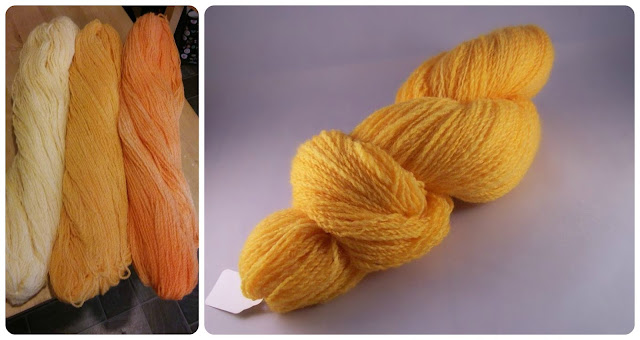First up is the fingering weight yarn, which is 106g/369m. I dyed this using Greener Shades dye at a dye depth of 1% in shade Sunrise Yellow. A 1% dye depth means that you use 1g of dye for every 100g of yarn.
I had decided that I wanted to have a go at trying to obtain a set of peach yarns. Peach can be a difficult colour to achieve, getting the tone right is a nightmare, nevermind having to try to get three different shades. I was using my micro scales to weigh out the tiny tiny amounts of dye needed in the percentages of each colour required and a milk bottle screw top cap was "the bowl" to weigh the dye into.
This first yarn is 105g/300m, dyed using Greener Shades dye at a dye depth of 0.1%, made up of 75% Sunrise Yellow and 25% Sunset Orange. A dye depth of 0.1% means that you use 0.1g of dye for every 100g of yarn and then this total amount of dye is split 75/25 between 2 colours. Can you imagine weighing out 0.075g of dye and 0.025g of dye to make up that one-tenth of a gram of dye required!
This yarn is just as I had hoped for.
This yarn is 104g/317m, dyed using Greener Shades dyes at a dye dept of 0.2%, 75% Sunrise Yellow, 25% Sunset Orange. Technically this is just a dark shade of the first yarn. The colours and percentages used are exactly the same, its just the dye depth that is increased, which means that I use double the weight of dye for the same amount of yarn which produces as stronger/darker shade. Not too bad, a tad orange, but maybe that was my dye weighing. The micro scales that I have are not the best as a really really good accurate set cost a lot of money, which I hope one day I will be able to afford to get.
The final yarn in the set of three is 105g/296m and again dyed with Greener Shades dye at a dye depth of 0.2% made up of 75% Sunset Orange and 25% Ruby Red. With hindsight I am thinking that instead of shifting dye colours and introducing Ruby Red that perhaps I should have just doubled the amounts of dye used on the previous 2 skeins again to make a 0.4% dye depth or even calculated for a 0.3% dye depth. I am sure the contrast will work on my chosen project though.
And finally a pretty photo to show all 3 colours off together.
Want to know how I made the yarn for this shawl? Just click Portland Fleece Part I







